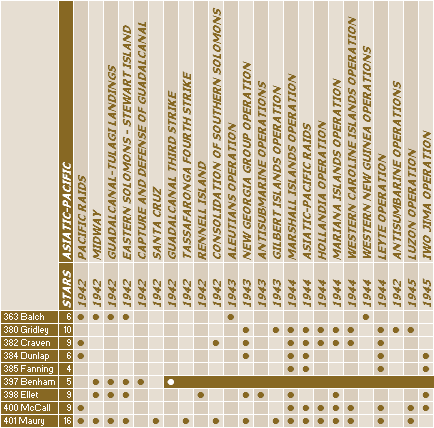
Caution: The purpose of this essay is to identify operations for which service stars were earned as indicated in the accompanying table. It has been compiled from secondary sources such as the Dictionary of American Fighting Ships which, in most cases, are silent about squadrons and divisions. Some statements, particularly regarding the dates of organization changes, reflect educated guesses. Verification will require examination of records such as war diaries and deck logs.
On 7 December 1941, the entire squadron was at sea with Enterprise (CV 6) and cruisers Chester, Northampton and Salt Lake City under VAdm. William F. Halsey, Jr., which was returning to Oahu after flying off aircraft for Wake Island, and thus missed the Japanese attack on Pearl Harbor.
| CONTENTS | |
| 947K | Selected entries from 1942 and 1943. |
In January 1942, DesRon 6 sortied with VAdm. Halsey’s Task Force 8 to strike the Marshall Islands. Fanning and Gridley collided during a rain squall and retired. Dunlap and cruisers shelled Wotje Atoll, sinking one enemy gunboat and damaging another. McCall hit Wotje, Maleolap and Kwajalein. Balch and Maury and cruisers hit Taroa and Maleolap and—on a separate mission in late February—Wake Island. Thereafter, Dunlap operated from Hawaii and the West Coast before moving to Nouméa, New Caledonia in December.
After repairs, Fanning returned in April to join Balch, Benham and Ellet in VAdm. Halsey’s Task Force 16, again screening Enterprise during the Doolittle raid on Japan. Fanning then drew escort assignments similar to Dunlap’s before going to the Solomon Islands in November. After a year there in supporting roles, she returned to San Francisco for overhaul and then went to the Aleutians.
At the Battle of Midway in June, Balch, Benham and Ellet plus Maury from DesDiv 11 and Conyngham from DesDiv 5 were attached to RAdm. Raymond A. Spruance’s Task Force 16, screening Enterprise and Hornet. Balch and Benham respectively rescued 545 and 908 survivors when Yorktown and Hammann were sunk on the 6th.
World War II Operations of the destroyers
originally attached to Destroyer Squadron 6
Next, Balch, Benham, Ellet and Maury went to the Solomon Islands. For the Guadalcanal–Tulagi landings in early August:
Balch, Benham, Ellet and Maury were still with Enterprise, North Carolina, Portland and Atlanta for the Battle of the Eastern Solomons at the end of the month. Thereafter:
In June 1943, all eight ships plus anti-aircraft cruisers San Diego and San Juan formed the screen for carriers Saratoga and HMS Victorious (operating as USS Robin), which covered the launching of Operation “Cartwheel” in the Solomon Islands’ New Georgia Group.
In January 1944, the full squadron was attached to RAdm. Samuel P. Ginder’s Task Group 58.3 with cruisers Boston, Baltimore and San Juan screening carriers Saratoga, Princeton and Langley in strikes on Wotje, Maloelap and Eniwetok in the Marshall Islands.

Click for maps . . .
In March and April, DesDiv 11 sailed from Majuro to screen the carriers in strikes on Palau, Yap, Ulithi, Woleai, covered the invasion of Hollandia, and raided Truk, Satawan, and Ponape. Moving to the Marianas in June, it and DesRon 46 and the cruisers, with Canberra and Oakland added, screened Hornet, Yorktown, Belleau Wood and Bataan in RAdm. “Jocko” Clark’s Task Group 58.1 during the Battle of the Philippine Sea on 19–20 June. In July, from Eniwetok, they struck Iwo Jima, Guam, Yap, Ulithi and the Volcano Islands. In September, they supported the Palau landings.
From DesDiv 12, Case, too, continued on with the carriers. In March, meanwhile, Dunlap, Fanning and Cummings were detached.
Now screening Franklin, Enterprise, San Jacinto and Belleau Wood in RAdm. Ralph E. Davison’s Task Group 38.4, the reconstituted DesRon 6 and DesDiv 24 struck Okinawa and Formosa, struck the Japanese Center force in the Battle of the Sibuyan Sea on the 24th and participated in the Battle off Cape Engaño on the 25th.
After availability at Manus, the squadron was reassigned to RAdm. Calvin T. Durgin’s Task Group 77.4 built around escort carriers Makin Island, Lunga Point, Bismarck Sea, Salamaua and Hoggatt Bay, which sailed on 27 December for Lingayen Gulf to support the Luzon invasion. En route on 5 January, Helm was one of several ships crashed by suicide planes off Mindoro.
Tired and showing signs of structural failure that prevented them from mounting 40mm anti-aircraft guns to counter the growing kamikaze threat, however, the remaining three Gridleys did not last much longer on the front line:
Accordingly, DesRon 6 was reformed one more time. While all five Bagleys were combined in DesDiv 11, a new DesDiv 12 consisted of 1,630-tonners—the three survivors from DesDiv 34 and Satterlee, the only ship from DesDiv 36 not converted as a minesweeper. Reassigned to the Fifth Fleet in February, Bagley, Helm, Ralph Talbot and Patterson operated at Iwo Jima and in the spring, after Mugford returned, moved on to Okinawa with Shubrick and Tillman. There,
Thereafter, ships of the squadron screened escort carriers and escorted convoys, typically between Leyte, the Marianas and the Ryukyus, until the war ended, when two Bagleys were given the honor of participating in surrender ceremonies before repatriating prisoners of war and returning home:
Sources: Morison, Rohwer, Roscoe, Hyperwar: United States Fleet Pacific Organization, 1 May 1945; Naval History & Heritage Command including Dictionary of American Naval Fighting Ships histories for individual ships.